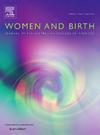Understanding midwifery workforce retention: An Australian cross-sectional study
IF 4.1
2区 医学
Q1 NURSING
引用次数: 0
Abstract
Problem
Retention is a known challenge in international and Australian midwifery workforce.
Background
Identification of drivers of workforce retention is essential to enable strategic planning for service delivery, consistent with workforce trends. Limited contemporary, midwifery-specific workforce data within Western Australia (WA) exists.
Aim
To explore midwives’ perspectives of factors contributing to retention, and views on their working environment.
Methods
An anonymous cross-sectional survey was conducted with midwives within the largest maternity service in WA. Quantitative data were analysed using descriptive statistics and structural equation modelling. Qualitative data underwent content analysis.
Findings
A total 193 midwives participated. Modelling demonstrated that perceptions of workplace culture was positively associated with the probability of midwives feeling acknowledged by the organisation for their work (OR=6.61, p < .001), and with better midwifery retention (b=3.34, p < .001). Acknowledgement was not a significant direct predictor of retention (b=1.12, p = .150), thus, was not a significant mediator of the association between workplace culture and retention. Top three reasons influencing midwives’ intention to stay were pay (89.6 %), patient ratios reflecting acuity (82.4 %) increasing the profile of the midwifery profession (80.8 %). Content analysis of midwives’ perspectives on retention factors exposed three categories: Intraprofessional relationships; Valuing the workforce; Career satisfaction.
Discussion
Midwives’ perspectives on retention emphasise the need for transformational leadership, professional recognition, and workplace empowerment as key strategies for sustaining the midwifery workforce.
Conclusion
Findings provide novel insight into indicators of WA midwifery workforce retention. Recommendations for midwife-driven solutions provide direction to enable midwifery leadership to support sustainable midwifery workforce retention into the future.
理解助产士劳动力保留:一项澳大利亚横断面研究
问题挽留是国际和澳大利亚助产人员面临的一个众所周知的挑战。背景确定劳动力保留的驱动因素对于实现符合劳动力趋势的服务提供战略规划至关重要。有限的当代,助产士特定的劳动力数据在西澳大利亚州(WA)存在。目的探讨助产士对挽留因素的看法,以及对助产士工作环境的看法。方法对西澳最大的妇产服务机构的助产士进行匿名横断面调查。定量数据分析采用描述性统计和结构方程模型。定性数据进行内容分析。调查结果共193名助产士参与。建模表明,对工作场所文化的看法与助产士感到组织认可其工作的可能性呈正相关(OR=6.61, p <; )。助产士保留率较高(b=3.34, p <; .001)。确认不是保留率的显著直接预测因子(b=1.12, p = )。150),因此,并不是一个显著的中介工作场所文化和保留之间的关系。影响助产士留院意向的前三大原因分别是薪酬(89.6 %)、反映病人视力的比率(82.4 %)和助产专业的情况(80.8 %)。助产士对保留因素的观点的内容分析揭示了三类:专业内关系;重视劳动力;职业满意度。助产士关于保留的观点强调了变革型领导、专业认可和工作场所赋权作为维持助产士队伍的关键战略的必要性。结论:研究结果为西澳助产人员保留指标提供了新的见解。关于助产士驱动的解决方案的建议提供了方向,使助产士领导能够支持未来可持续的助产士劳动力保留。
本文章由计算机程序翻译,如有差异,请以英文原文为准。
求助全文
约1分钟内获得全文
求助全文
来源期刊

Women and Birth
NURSING-OBSTETRICS & GYNECOLOGY
CiteScore
7.20
自引率
13.20%
发文量
371
审稿时长
27 days
期刊介绍:
Women and Birth is the official journal of the Australian College of Midwives (ACM). It is a midwifery journal that publishes on all matters that affect women and birth, from pre-conceptual counselling, through pregnancy, birth, and the first six weeks postnatal. All papers accepted will draw from and contribute to the relevant contemporary research, policy and/or theoretical literature. We seek research papers, quality assurances papers (with ethical approval) discussion papers, clinical practice papers, case studies and original literature reviews.
Our women-centred focus is inclusive of the family, fetus and newborn, both well and sick, and covers both healthy and complex pregnancies and births. The journal seeks papers that take a woman-centred focus on maternity services, epidemiology, primary health care, reproductive psycho/physiology, midwifery practice, theory, research, education, management and leadership. We also seek relevant papers on maternal mental health and neonatal well-being, natural and complementary therapies, local, national and international policy, management, politics, economics and societal and cultural issues as they affect childbearing women and their families. Topics may include, where appropriate, neonatal care, child and family health, women’s health, related to pregnancy, birth and the postpartum, including lactation. Interprofessional papers relevant to midwifery are welcome. Articles are double blind peer-reviewed, primarily by experts in the field of the submitted work.
 求助内容:
求助内容: 应助结果提醒方式:
应助结果提醒方式:


